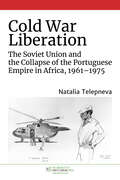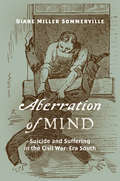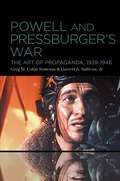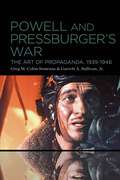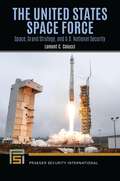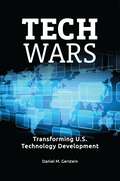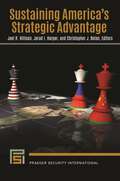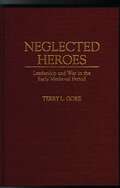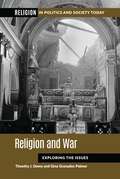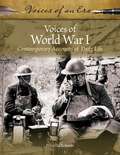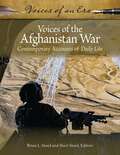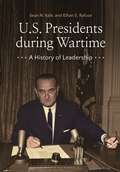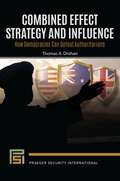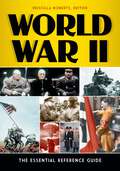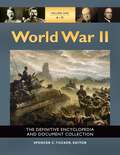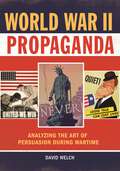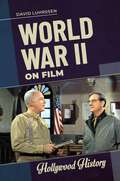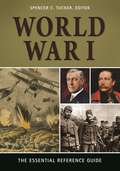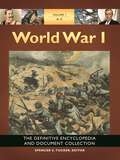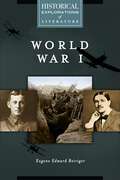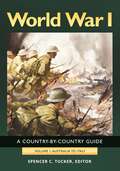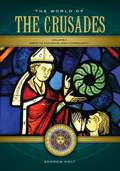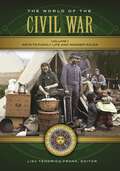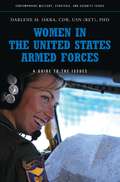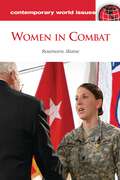- Table View
- List View
Cold War Liberation: The Soviet Union and the Collapse of the Portuguese Empire in Africa, 1961–1975 (New Cold War History)
by Natalia TelepnevaCold War Liberation examines the African revolutionaries who led armed struggles in three Portuguese colonies—Angola, Mozambique, and Guinea-Bissau—and their liaisons in Moscow, Prague, East Berlin, and Sofia. By reconstructing a multidimensional story that focuses on both the impact of the Soviet Union on the end of the Portuguese Empire in Africa and the effect of the anticolonial struggles on the Soviet Union, Natalia Telepneva bridges the gap between the narratives of individual anticolonial movements and those of superpower rivalry in sub-Saharan Africa during the Cold War. Drawing on newly available archival sources from Russia and Eastern Europe and interviews with key participants, Telepneva emphasizes the agency of African liberation leaders who enlisted the superpower into their movements via their relationships with middle-ranking members of the Soviet bureaucracy. These administrators had considerable scope to shape policies in the Portuguese colonies which in turn increased the Soviet commitment to decolonization in the wider region. An innovative reinterpretation of the relationships forged between African revolutionaries and the countries of the Warsaw Pact, Cold War Liberation is a bold addition to debates about policy-making in the Global South during the Cold War. We are proud to offer this book in our usual print and ebook formats, plus as an open-access edition available through the Sustainable History Monograph Project.
Aberration of Mind: Suicide and Suffering in the Civil War–Era South
by Diane Miller SommervilleMore than 150 years after its end, we still struggle to understand the full extent of the human toll of the Civil War and the psychological crisis it created. In Aberration of Mind, Diane Miller Sommerville offers the first book-length treatment of suicide in the South during the Civil War era, giving us insight into both white and black communities, Confederate soldiers and their families, as well as the enslaved and newly freed. With a thorough examination of the dynamics of both racial and gendered dimensions of psychological distress, Sommerville reveals how the suffering experienced by Southerners living in a war zone generated trauma that, in extreme cases, led some Southerners to contemplate or act on suicidal thoughts. Sommerville recovers previously hidden stories of individuals exhibiting suicidal activity or aberrant psychological behavior she links to the war and its aftermath. This work adds crucial nuance to our understanding of how personal suffering shaped the way southerners viewed themselves in the Civil War era and underscores the full human costs of war.
Powell and Pressburger’s War: The Art of Propaganda, 1939-1946
by Professor Greg M. Semenza Garrett A. Sullivan Jr.A focused study on Michael Powell and Emeric Pressburger's cinematic contributions to the war effort, arguing for the centrality of propaganda to their work as film artists.Michael Powell and Emeric Pressburger are widely hailed as two of the greatest filmmakers in British cinema history. The release of their first movie, The Spy in Black, barely preceded the beginning of World War Two, and a number of their early masterworks, including The Life and Death of Colonel Blimp, A Canterbury Tale, and A Matter of Life and Death, were produced in the service of the war effort. Through exploring the relationship between art and propaganda, this book shows that Powell and Pressburger saw no contradiction between their aesthetic ambitions and their cinematic war work: propaganda imperatives were highly conducive to their objectives as both commercial cinema practitioners and artists.Drawing on production materials from the archives of the British Film Institute, this book charts three phases in Powell and Pressburger's wartime career: from first-time collaborators who strive to reconcile popular cinematic forms with developing notions of what constitutes effective propaganda; to accomplished, and sometimes controversial, propagandists whose movies center upon Britain's relations with its enemies and allies; to filmmakers whose responsiveness to the propaganda requirements of the late war is matched by a focus, shared by the Ministry of Information, on what the post-war future would bring.
Powell and Pressburger’s War: The Art of Propaganda, 1939-1946
by Professor Greg M. Semenza Garrett A. Sullivan Jr.A focused study on Michael Powell and Emeric Pressburger's cinematic contributions to the war effort, arguing for the centrality of propaganda to their work as film artists.Michael Powell and Emeric Pressburger are widely hailed as two of the greatest filmmakers in British cinema history. The release of their first movie, The Spy in Black, barely preceded the beginning of World War Two, and a number of their early masterworks, including The Life and Death of Colonel Blimp, A Canterbury Tale, and A Matter of Life and Death, were produced in the service of the war effort. Through exploring the relationship between art and propaganda, this book shows that Powell and Pressburger saw no contradiction between their aesthetic ambitions and their cinematic war work: propaganda imperatives were highly conducive to their objectives as both commercial cinema practitioners and artists.Drawing on production materials from the archives of the British Film Institute, this book charts three phases in Powell and Pressburger's wartime career: from first-time collaborators who strive to reconcile popular cinematic forms with developing notions of what constitutes effective propaganda; to accomplished, and sometimes controversial, propagandists whose movies center upon Britain's relations with its enemies and allies; to filmmakers whose responsiveness to the propaganda requirements of the late war is matched by a focus, shared by the Ministry of Information, on what the post-war future would bring.
The United States Space Force: Space, Grand Strategy, and U.S. National Security (Praeger Security International)
by Lamont C. ColucciThe United States Space Force, the sixth branch of the armed forces, will soon play a leading role in American foreign policy and will be necessary to protect its economic, political, and social interests at home and abroad.This book argues that America's newest branch of the armed forces, the United States Space Force, will soon play a key strategic role in American foreign policy, military and economic expansion, and technological innovation. Written by a leading expert on and member of the Space Force, the book offers an introduction to the Space Force, explains the urgent need for it, and walks readers through what exactly the Space Force is and is not. Drawing on dozens of interviews with high-ranking members of the armed forces, the author claims that, in the future, space will be the geopolitical center of world politics, as such countries as the U.S., Russia, and China jockey for control of it. America must therefore set aside partisan politics to make space a top priority, as a failure to do so will leave the U.S. and its citizens in a dangerous and vulnerable position on the world stage.
Tech Wars: Transforming U.S. Technology Development
by Daniel M. GersteinThis book explores the evolution of the current U.S. research and development enterprise, asks whether this organization remains appropriate to the challenges we face today, and proposes strategies for better preparing for the global technology race shaping our future.Across the globe, nation states and societies, as well as corporations, technology developers, and even individuals, find themselves on the front lines of a global technology race. As we approach the third decade of this century, the outlines of the contest have become clear. Spending on research and development, such new methods as innovation centers, and inclusion of powerful technologies into governments and society are occurring at a rapid pace. Technology winners and losers are emerging.How did we arrive at this global technology fight? How and where will it be waged? What can we do to prepare for the future? In 10 chapters, Tech Wars addresses these questions and more, examining the conditions that have led us to this point and introducing new strategies, organizational changes, and resource allocations that will help the United States respond to the challenges that are on the horizon.
Sustaining America's Strategic Advantage (Praeger Security International)
by Joel R. Hillison, Jerad I. Harper, and Christopher J. Bolan, EditorsWritten for foreign policy practitioners, scholars, and students, this book offers critical insights into the modern landscape of international politics and warfare and explains how the United States can sustain its strategic advantages in the 21st century and beyond.From the level of grand strategy to more intricate security issues, this book explores how the United States can sustain its strategic military and political advantages around the world. Developing and implementing effective national policies; fostering strong diplomatic and geopolitical ties with allies in Europe, the Indo-Pacific, and the Middle East; and managing an effective defense enterprise are key, according to the authors, to competing on a shifting international security landscape. Advancing the literature on grand strategy and outlining emerging critical issues in security, this book offers an overarching framework for strategy; an analysis of crucial security-related topics, such as cyber warfare; and informed opinions on components of competitive success, such as irregular warfare and partner building. Written by well-respected scholars, security professionals, and foreign policy practitioners, this book goes beyond focusing on hard power to consider how the U.S. can leverage its education institutions and a worldwide network of allies and partners to sustain its strategic advantage now and in the future.
Neglected Heroes: Leadership and War in the Early Medieval Period
by Terry L. GoreContrary to prevalent military historical thinking, the early medieval general was not an ignorant warrior chieftain, but an able, astute, intelligent, and often very cunning commander. Through the use of contemporary literature, art, and archaeological evidence, this study argues that these generals could and did effectively exercise command control before, during, and after battle. Using the examples of a dozen or so leaders and drawing upon over 60 battles, this study brings to light the genius and the adaptability of medieval generals.
Religion and War: Exploring the Issues (Religion in Politics and Society Today)
by Timothy J. Demy Gina Granados Ph.D.Looking at topics across the spectrum of America's wars, religious groups, personalities, and ideas, this volume shows that even in an increasingly secular society, religious roots and values run deep throughout American society and are elevated in times of war.There is a long and deep relationship between religion, politics, and war in U.S. history. While there is a constitutional and legal separation of religion and the state in American society, religion has been and remains a potent force in American culture and politics affecting many aspects of life, including perspectives on war and peace and the experience of war in U.S. history. From the American Revolution to the wars of the 21st century, religious values have informed and influenced American attitudes toward war and peace and have provided rationale for support and non-support of American participation in conflicts.An overview essay surveys the background and significance of religion in American culture and provides historical context for discussions of contemporary topics. A timeline highlights key events related to wars and conflicts. The volume then includes more than 50 topical essays that discuss specific wars as well as religious themes within culture and politics, ultimately providing a detailed overview of the intersection of religion, war, and politics in contemporary America.
Voices of World War I: Contemporary Accounts of Daily Life (Voices of an Era)
by Priscilla RobertsBringing together a diverse collection of primary source documents, this book illuminates the events and experiences of World War I from a variety of perspectives, from soldiers on the front lines to civilians supporting the war effort at home.Part of Bloomsbury's Voices of an Era series, this carefully curated collection highlight the wartime experiences of a diverse array of individuals from around the globe. In addition to covering major military innovations and turning points, documents explore how issues of gender, race,diplomacy, and empire building impacted individuals' experience of the Great War.Each of the 42 documents includes contextual information and thought-provoking questions to guide readers in their exploration of the text. In addition to high-interest sidebars, in-text glossary definitions, biographical snapshots of key figures, and a comprehensive chronology of the war, the book also includes a guide to evaluating and interpreting primary sources that bolsters readers' analytical and critical thinking skills.Although it was nicknamed "the war to end all wars," World War I heralded the start of modern-day conflicts. The human toll of the Great War was immense-an estimated 9 million soldiers died on the battlefield, while more than 5 million civilians died as the result of military actions, disease, or famine. In the wake of World War I, empires crumbled and new nations won their independence. Although the events and aftermath of World War I happened on an epic scale, the conflict is best understood through the human lens provided by these primary sources.
Voices of the Afghanistan War: Contemporary Accounts of Daily Life (Voices of an Era)
by Brian L. Steed Sheri SteedThe War in Afghanistan was the longest military conflict in American history. In a diverse collection of primary documents, this book explores the evolving legacy of the war and its impact on the countless lives it changed forever. Following the terrorist attacks on September 11, 2001, the United States spent almost 20 years at war in Afghanistan until it officially withdrew its military forces in August 2021. As the longest war in American history, the War in Afghanistan cost trillions of dollars to sustain and claimed the lives of thousands of American soldiers and many more Afghan civilians. This book tells the story of the war from its varied perspectives, including documents from American and Afghan politicians, high-ranking military officers, and diplomats. The topics covered are even more diverse, ranging from the building and training of security forces and the use drones in modern warfare to the importance of education and the role of women in combat. What the editors lead readers to understand is that the peoples referred to as Afghans have little in common beyond the land itself-a simple, basic, and ultimately ignored reality at the heart of the U.S. invasion, occupation, and frustration in Afghanistan.
U.S. Presidents during Wartime: A History of Leadership
by Sean N. Kalic Ethan S. RafuseFrom the American Revolution to the War in Afghanistan, the United States has had no shortage of conflicts on both domestic and world stages. All provide insight into the values of the presidents who led the nation through them.U.S. Presidents during Wartime: A History of Leadership takes readers through chronological entries of presidents who participated in key wars throughout U.S. history. An overview essay first considers the social, economic, and political factors that affected presidents during war. Entries beginning with the presidency of George Washington and ending with that of George W. Bush comprehensively cover each war therein, as well as the responses of the relevant presidents.Primary documents in each entry depict the perspectives of the presidents and offer opportunities for comparing and contrasting the presidents' engagements in wartime strategies. Ending each entry are chronologies of the various events and conflicts that marked the president's time in office. Moreover, entries build upon each other to help readers toward a broader understanding of the sum impact of the wars that the presidents led. While the book emphasizes the historical record, it also explores ongoing conflicts through the lens of contemporary U.S. presidents to provide readers with a complete picture of the changing nature of war over time.
Combined Effect Strategy and Influence: How Democracies Can Defeat Authoritarians (Praeger Security International)
by Thomas A. DrohanOffering a competitive strategy to defeat authoritarians' all-domain warfare, this book suggests a new combined effects and influence framework for democracies to employ before deterrence fails.Breaking new ground in this comprehensive study, retired Brigadier General Thomas A. Drohan reforms an entrenched legacy concept-coercive compellence and deterrence. The book's framework synthesizes brute force, coercion, combined arms, and concepts of operations into combined effects and concepts of influence, including narrative warfare with cognitive exploits. The survey of competitive strategy at the beginning of the book spans a time frame from the thinking of ancient civilizations all the way to artificial intelligence, providing broad historical context for this model. The contemporary cases that test the model focus on complex competition and confrontation during the past 75 years.Combined Effect Strategy and Influence is unique in its critique of democracies' dominant paradigm of international security and its broad, specific framework ready for strategists, analysts, planners, and operators to apply to current threats. Students, researchers, and any leader interested in developing superior strategy will value the book's insights on gaining an advantage against emerging threats.
World War II: The Essential Reference Guide
by Priscilla RobertsIn this book an internationally renowned team of historians provides comprehensive coverage of all major campaigns and theaters of World War II, synthesizing the tremendous breadth and depth of source materials on this global conflict. It includes primary-source documents created by both famous leaders and average citizens.World War II: The Essential Reference Guide provides a comprehensive overview of the major events, campaigns, battles, personalities, and issues of World War II, supplemented by a selection of primary-source documents. Comprising essays written by leading international scholars that introduce non-specialist readers to all the major theaters of the war, this volume covers the entire span—both geographically and chronologically—of this far-reaching conflict.A selection of official and personal documents conveys the emotionally charged tenor of the period and the tremendous psychological impact of the war on those involved in it, both directly and indirectly. The book includes scholarly essays on enduring dilemmas of World War II, such as whether the United States justified in dropping the atomic bomb on Japan, as well as comprehensive essays on the causes, course, and consequences of the war.
World War II [5 volumes]: The Definitive Encyclopedia and Document Collection [5 volumes]
by Dr Spencer C. TuckerWith more than 1,700 cross-referenced entries covering every aspect of World War II, the events and developments of the era, and myriad related subjects as well as a documents volume, this is the most comprehensive reference work available on the war.This encyclopedia represents a single source of authoritative information on World War II that provides accessible coverage of the causes, course, and consequences of the war. Its introductory overview essays and cross-referenced A–Z entries explain how various sources of friction culminated in a second worldwide conflict, document the events of the war and why individual battles were won and lost, and identify numerous ways the war has permanently changed the world. The coverage addresses the individuals, campaigns, battles, key weapons systems, strategic decisions, and technological developments of the conflict, as well as the diplomatic, economic, and cultural aspects of World War II.The five-volume set provides comprehensive information that gives readers insight into the reasons for the war's direction and outcome. Readers will understand the motivations behind Japan's decision to attack the United States, appreciate how the concentration of German military resources on the Eastern Front affected the war's outcome, understand the major strategic decisions of the war and the factors behind them, grasp how the Second Sino-Japanese War contributed to the start of World War II, and see the direct impact of new military technology on the outcomes of the battles during the conflict. The lengthy documents volume represents a valuable repository of additional information for student research.
World War II Propaganda: Analyzing the Art of Persuasion during Wartime
by David WelchShows in illuminating detail how the Allied and Axis forces used visual images and other propaganda material to sway public opinion during World War II.Author David Welch provides a neatly organized primary resource that focuses on key themes associated with World War II propaganda. Readers will not only be engrossed with a wide range of propaganda artifacts, they will also receive a better and more nuanced understanding of the nature of this propaganda and how it was disseminated in different cultural and political contexts. This book reveals how leaders and spin doctors operating at behest of the state sought to shape popular attitudes both at home and overseas. A comprehensive introductory essay sets out the principles of propaganda theory in World War II, while the subsequent material provides examples of Allied- and Axis-generated propaganda and presents them in a readily accessible way that will help readers understand the context.
World War II on Film (Hollywood History)
by David LuhrssenWorld War II on Film examines the war through the lens of 12 films. The movies selected include productions made during World War II and in each succeeding decade, providing a sense of how different generations perceive the war.World War II on Film provides a succinct yet well-grounded appraisal of that war as seen through 12 representative films. The book separates fact from fiction, showing where the movies were accurate and where they departed from reality, and places them in the larger context of historical and social events. Each movie chosen represents a particular aspect of the conflict, including the air war over Europe, the condition of prisoners of war, Nazi atrocities, and the British evacuation at Dunkirk. Unlike most histories of Hollywood during World War II or the genre of war movies, World War II on Film examines in depth the relation between the depictions of events, beliefs, attitudes, and ways of life as seen on film with reality as documented by historians or recorded by journalists or eye-witnesses to the war. The volume will appeal to high school and college readers, as well as general interest readers and film buffs.
World War I: The Essential Reference Guide
by Spencer C. Tucker, EditorWith its authoritative reference entries, multiple introductory and perspective essays, primary source documents, detailed chronology, and bibliography, this single-volume reference provides all the key information readers need to understand this monumental conflict.World War I was an epic conflict that toppled centuries-old empires, transformed the Middle East and Russia, and helped elevate the United States to prominence as a world power. In essence, understanding the reasons for and outcomes of the First World War provides a cornerstone for knowledge of all modern history. In World War I: The Essential Reference Guide, detailed reference entries, a comprehensive overview essay, plus additional examinations of the causes and consequences of the conflict provide readers with the context needed to understand all aspects of World War I.Important primary source documents like the Zimmerman Telegram and Balfour Declaration are included and accompanied by explanations that supply readers with key historical perspective. Biographies on major political and military leaders, such as Wilhelm II, Woodrow Wilson, Nicholas II, John Pershing, and Ferdinand Foch, offer insight into the people who played key roles in the conflict. Entries on the key confrontations of the war—many accompanied by maps—showcase the strategies of both sides in their attempts to emerge victorious, and the bibliography presents a wealth of options to students looking to conduct further research on World War I.
World War I [5 volumes]: The Definitive Encyclopedia and Document Collection [5 volumes]
by Spencer C. TuckerOffering exhaustive coverage, detailed analyses, and the latest historical interpretations of events, this expansive, five-volume encyclopedia is the most comprehensive and detailed reference source on the First World War available today.One hundred years after the beginning of World War I in 1914, this conflict still stands as perhaps the most important event of the 20th century. World War I toppled all of the existing empires at the time, transformed the Middle East, and vaulted the United States to becoming the world's leading economic power. Its effects were profound and lasting—and included outcomes that led to World War II. This multivolume encyclopedia provides a wide-ranging examination of World War I that covers all of the important battles; key individuals, both civilian and military; weapons and technologies; and diplomatic, social, political, cultural, military, and economic developments.Suitable as a reference tool for high school and undergraduate students as well as faculty members and graduate-level researchers, World War I: The Definitive Encyclopedia and Document Collection offers accessible, in-depth information and up-to-date analyses in a format that lends itself to quick and easy use. The set comprises alphabetically arranged, cross-referenced entries accompanied by further reading selections as well as a comprehensive bibliography. A fifth volume provides chronologically arranged documents and an A–Z index.
World War I: A Historical Exploration of Literature (Historical Explorations of Literature)
by Eugene Edward BeirigerFocusing on the war on the Western and Southern fronts and inclusive of material from all sides of the conflict, this book explores the novels and poems of significant soldier-writers alongside important contemporary historical documents.The literary works of the First World War are one of the richest sources we have for understanding one of the twentieth century's most significant conflicts. Not only do many of them have historical merit, but some were critically acclaimed by both contemporaries and subsequent scholars. For example, Henri Barbusse's Under Fire, one of the earliest novels of the war, won accolades in France and the respect of war poets Siegfried Sassoon and Wilfred Owen as well as novelists Erich Maria Remarque and Ernest Hemingway.This book examines these works and those of war poets Rupert Brooke and John McCrae and others, providing context as well as opportunities to explore thematic elements with primary source documents, such as diaries, letters, memoirs, newspaper and journal articles, speeches, and government publications. It is unique in its use of literary and historical sources as mediums by which to both better understand the literature of the war and use literature to better understand the war itself.
World War I [2 volumes]: A Country-by-Country Guide [2 volumes]
by Spencer C. TuckerOffers detailed coverage of every country that played a significant role in World War I, from key participants including France, Germany, Great Britain, the Ottoman Empire, and the United States, to smaller nations such as Bulgaria, Montenegro, and New Zealand.World War I: A Country-by-Country Guide is a comprehensive reference exploring the role various nations played in this devastating conflict. Each of the 22 country sections provides detailed background information, the reasons behind the country's entry into the war, a summary of its combat effort in the war, a discussion of the home front experience, and a description of the war's impact on that nation. Illuminating sidebars offer an interesting war anecdote involving each country, while essays survey each country's military branches and key military and political leaders. Finally, a timeline for each nation covers all of the important events involving that country during World War I. In addition to the country coverage, a battles section offers entries on 18 of World War I's most important engagements and a separate section on weapons and tactical changes is included. The book also features dozens of maps and images throughout the text that serve as important visual aids that help readers to understand all aspects of the conflict.
The World of the Crusades [2 volumes]: A Daily Life Encyclopedia [2 volumes] (Daily Life Encyclopedias)
by Andrew HoltUnlike traditional references that recount political and military history, this encyclopedia includes entries on a wide range of aspects related to daily life during the medieval crusades.The medieval crusades were fundamental in shaping world history and provide background for the conflict that exists between the West and the Muslim world today. This two-volume set presents fundamental information about the medieval crusades as a movement and its ideological impact on both the crusaders and the peoples of the East. It takes a broad look at numerous topics related to crusading, with the goal of helping readers to better understand what inspired the crusaders, the hardships associated with crusading, and how crusading has influenced the development of cultures both in the East and the West.The first of the two thematically arranged volumes considers topics such as the arts, economics and work, food and drink, family and gender, and fashion and appearance. The second volume considers topics such as housing and community, politics and warfare, recreation and social customs, religion and beliefs, and science and technology. Within each topical section are alphabetically arranged reference entries, complete with cross-references and suggestions for further reading. Selections from primary source documents, each accompanied by an introductory headnote, give readers first-hand accounts of the crusades.
The World of the Civil War [2 volumes]: A Daily Life Encyclopedia [2 volumes] (Daily Life Encyclopedias)
by Lisa Tendrich FrankCovering everything from the arts to food and drink, religion, social customs, and technology, this two-volume set provides an in-depth, accessible look at the social, cultural, economic, and political aspects of the American Civil War.The American Civil War caused dramatic changes in every aspect of life and society, affecting combatants and noncombatants at all levels of the socioeconomic scale. The World of the Civil War: A Daily Life Encyclopedia offers an accessible and reliable reference for the major topics that defined American life during the nation's most tumultuous era. Taking a blended approach to history, this book covers the military and political history of the era and examines the social and human experiences of the war, thereby offering a comprehensive look at the Civil War era's most significant events, people, places, and experiences.The thematic organization of this encyclopedia helps readers to more readily explore related topics. The subject matter explored in some 250 entries includes religious beliefs and practices; rites of passage; soldiers' lives and experiences; rural and urban life; social structure of the Civil War era—aristocrats, landowners, and slaves; men's and women's roles and responsibilities; holidays, festivals, and other celebrations; tools, machinery, and inventions; and justice and punishment. Readers will come away with an understanding of many aspects of daily life during the Civil War era and gain appreciation for the vast differences between life today and 150 years ago.
Women in the United States Armed Forces: A Guide to the Issues (Contemporary Military, Strategic, and Security Issues)
by Darlene M. IskraThis handbook provides the reader with an historical and contemporary overview of the service by women in all branches of the U.S. military, tracing the causes and effects of evolving policies, issues, structural barriers, and cultural challenges on the record and in the future of the accomplishments by women warriors.Women in the United States Armed Forces: A Guide to the Issues covers over a century of accomplishments of military women, from the Civil War to the current wars in the Middle East. Readers will learn, for example, that during World War II, 565 women in the Women's Army Corps stationed in the Pacific theater received combat decorations, proving that women had the courage, strength, and stamina to perform in a combat environment. They will also learn that, perhaps surprisingly, it wasn't until the mid- to late 1970s that women had their first opportunities to serve at sea and as aviators (crew as well as pilots), albeit on noncombatant ships and aircraft. The book's final four chapters discuss the issues that continue to plague women in the military, including sexual harassment, noting that women's performance in America's two-front wars in Iraq and Afghanistan have made a positive difference in attitudes. The handbook closes with an epilogue that is at once a summary of the issues and a call for action.
Women in Combat: A Reference Handbook (Contemporary World Issues)
by Rosemarie SkaineThis handbook provides a straightforward account of how women have served in combat roles and explains the ongoing controversy surrounding efforts to legalize combat assignments for female service members.Women have been excluded from combat roles for most of American history. During conflicts such as the American Civil War, a few women enlisted as men; in some cases, their identities as women were not discovered until after their deaths. Today, the nontraditional battlefields of Iraq and Afghanistan have no clearly defined front lines, and many female soldiers have found themselves face-to-face with the enemy. Yet despite the realities of modern warfare, the subject of women serving in combat roles remains highly controversial.Women in Combat: A Reference Handbook examines the historical background, current dilemmas, and global context of this contentious issue. The author explores both sides of the argument, presenting information from leading sources and gleaned from personal interviews. Statistical data, primary source documents, a directory of organizations, and print and electronic resources offer additional insight.
